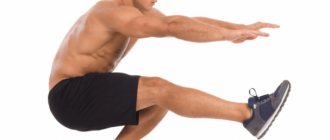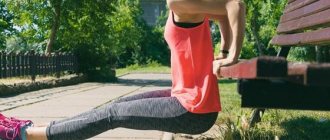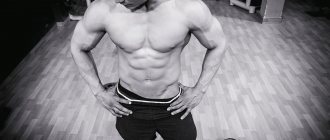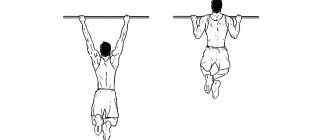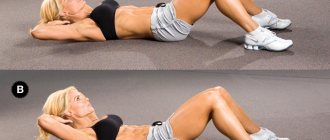The training program presented in the material is an example of a triple split for gaining weight in the gym. In other words, the program involves three powerful strength training sessions per week, each of which works a specific muscle group.
Note that such a mass training program is more suitable for advanced mesomorph athletes than for beginners - since not only basic but also isolating exercises are used. In addition, the program requires a high level of endurance and experience in gym training.
Gym training program
Training in the gym 3 times a week involves dividing the body into segments that combine different muscle groups. On the first day of the program, chest, biceps and leg exercises are combined. Since chest work doesn't involve your lower body, the second part of the workout allows you to work your legs.
On the second day, the muscles of the upper body are combined - triceps, shoulders and trapezius, while the chest and legs worked in the previous workout receive recovery. On the third day of the gym, it is necessary to pump up your back and abs - when working the back muscles, the biceps are also involved, but a sufficient amount of time has passed since its last workout.
// Pros of 3 workouts per week:
- develops mass and volume of the upper body
- suitable for cycle training
- great emphasis on the abs
- Convenient schedule (Mon, Wed, Fri)
// Minuses:
- reduced emphasis on leg muscles
- not suitable for ectomorphs or beginners
- implies a high level of load
- may lead to overtraining
Rules for creating your own weekly program
The ability to create an individual program for sports activities is a key characteristic of an advanced athlete and the dream of any beginner.
Preparation of such a program includes the following steps:
- write a basic training plan. First there should be a warm-up (about 10 minutes), 2 exercises for any of the main muscle groups (legs, back, chest), 3 exercises for secondary muscles (shoulders, biceps, triceps), and a cool-down (5 minutes). If you are focused on losing excess weight, you need to devote 20 minutes to cardio after strength training;
- set the main goal and objectives. The weakest muscle groups (especially if they are secondary) can be trained 2 times a week with a break of a couple of days for proper rest and recovery (for example, on Monday and Thursday);
Note! To work out your abs, you can include 3 sets of planks right into your warm-up, and leg raises or another similar exercise for several muscle groups during your cool-down.
- choose suitable exercise options. To the first set of exercises (load on large muscle groups), it is recommended to add basic loads or their variations on special exercise machines. You need to add isolated loads to the combination of small muscle exercises, changing them regularly to check the effectiveness. The selection of exercises largely depends on what exercise equipment and auxiliary devices you have in your home and gym;
- determine the number of approaches and repetitions. The total number of sets for each large muscle group should be 12-15 (i.e. 3 exercises of 4 sets or 4 exercises of 3-4 sets). The first set should use a fairly heavy weight and a minimum number of repetitions (from 8 to 12), while the second set should use a working weight and an increased number of repetitions (12 to 15).
Be sure to check out: Split program: training to pump up muscles with proven effectiveness Monthly training program: rules for drawing up a plan and sets of exercises Detailed training program with your own weight at home Effective training program for gaining muscle mass 3 times a week
// Day 1: chest, biceps, legs
The first day of the training program is the most difficult. It involves working the two largest muscle groups of the body - the chest and legs. Note that if you can go to the gym 4 times a week, it is better to devote a separate workout to your legs.
Pushups
An exercise to warm up and prepare the pectoral muscles for training. Vary different types and widths of hand placements, and use a footrest for added challenge. 2-3 sets of 12-15 reps
// Correct push-up technique
Chest information
The exercise is performed with an average working weight, control over the technique and a full feeling of involving the pectoral muscles in the work. Try to tighten and squeeze your chest inward as much as possible, pushing your arms forward - but without locking your elbows. 2-3 sets of 12-15 reps
Bench press
Basic exercise for the chest muscles. Can be performed both with a barbell and in a bench press machine. When performing on a horizontal bench, do not lift your legs up. Optionally, you can vary the incline of the bench every week. 3-4 sets of 7-10 reps
// Bench press - step by step technique
Barbell curls
Key exercise for developing biceps muscles. When performing, use a medium weight that allows you to perform up to 15 repetitions. Don't swing as you lift the barbell and keep your elbows at the same point. 2-3 sets of 12-15 repetitions.
// Lifting the barbell for biceps - how to do it?
Concentrated biceps curl
Always make sure you feel your biceps working. Due to the slight rotation of the dumbbell, the inner part of the biceps is included in the work - as the size increases, it pushes the main muscle upward, giving it volume. 2-3 sets of 12-15 reps
Squats
Basic exercise for the leg muscles. Can be performed both with a barbell and in a leg press machine. As you perform, keep your abs in conscious tension, lowering yourself to the point where your thighs are parallel to the floor. 3-4 sets of 7-10 repetitions.
// What do squats do and what muscles do they develop?
Leg extensions in the simulator
Exercise for targeted pumping of the anterior thigh. When doing this, also make sure that your abs remain in conscious tension. Don't help yourself lift the weight by arching your body. Can be replaced with another leg exercise. 2-3 sets of 12-15 reps
Lunges
Exercise to work the gluteus medius muscle. It can be performed both with body weight and with dumbbells. Optionally can be replaced with any other exercise for the buttocks. 2-3 sets of 12-15 reps
// The best exercises for the buttocks
V. Spread exercises throughout your workouts
After you have written out all the exercises, you need to distribute them among your workouts. How to scatter depends on the goal.
When gaining mass and/or strength – 1 – 3 muscle groups per workout (depending on the number of workouts). Not more. That is, you don’t need to try to pump all the muscles in every workout. As a hint, you can read: How to separate muscle groups when training for mass.
Losing weight - on the contrary, all muscles are trained a little at each workout. Here your task is to load the whole body and expend as much energy as possible.
Relief – it is possible to divide by type, both when gaining weight, and by type, as when losing weight. It depends on the method of performing the workout, on the characteristics of your body and on the focus of your diet.
Form support - well, there can be any option. Depending on how you achieved this shape: through weight loss or through weight gain.
// Day 2: Shoulders, triceps, traps
The second day of the training program focuses on the upper half of the body. The goal is to work out the muscles that give the figure massiveness. Round and voluminous shoulders will make the figure wider, and large triceps will increase the volume of the arms, visually expanding the biceps.
Reverse push-ups on a bench
An exercise to warm up the upper body and prepare joints for work. It can be performed both from the ground and on two benches - push-ups on uneven bars are also acceptable. At the top, try to push your body weight as high as possible. 2-3 sets of 12-15 repetitions.
// Reverse triceps push-ups - step by step
Dumbbell lateral raises
Exercise for the middle part of the deltoid muscles. When performing, use medium weight dumbbells and control the stationary position of the body. The back should be straight, the arms should not bend at the elbows. Raise the weight to horizontal. 2-3 sets of 12-15 reps
Front dumbbell raises
Exercise for the front of the deltoid muscles. Also use medium weight dumbbells and watch your form. Start raising your arm only when the opposite arm is at the bottom of the movement. 2-3 sets of 12-15 reps
Seated dumbbell press
Basic exercise for the shoulder muscles. It can be performed either with dumbbells (both sitting on a bench and standing) or with a barbell - standing barbell press. When performing, keep your abs in conscious tension; when lifting the weight up, do not push it out using the strength of your core - only your shoulders work. 3-4 sets of 7-10 reps
Reverse triceps extensions
An exercise for the middle head of the triceps that gives volume to the muscle. It can be performed either with dumbbells on a bench or in a machine with a rope (the body is strictly perpendicular to the floor). Make slow movements, tensing your triceps even more at the final point of the movement. 2-3 sets of 12-15 reps
Overhead triceps press
A key exercise for developing triceps. Can be performed either sitting on a bench or lying on a bench (with an EZ bar). The elbows should be parallel to each other and should not move to the side when moving the weight. Can be replaced with another triceps exercise. 3-4 sets of 7-10 reps
// How to properly pump your triceps?
Lateral dumbbell raises
Exercise to work the trapezius and middle deltoid muscles. When lifting dumbbells, the elbows are slightly bent, moving in a semicircle. Make sure that your lower back does not arch. 3-4 sets of 7-10 reps
Lifting dumbbells to the chin
Exercise for trapezius and deltoid muscles. Gives the shoulders a characteristic rounded shape. When lifting up, make sure not to lift the dumbbells too high - strictly to the parallel line. Perform the exercise slowly, engaging as many muscle fibers as possible. 2-3 sets of 12-15 reps
Download printable training diary for free
Since we have already touched on this topic, we decided to prepare a free training diary for you. Enter all the information for each workout into it and conduct an interim analysis of their effectiveness yourself or with the help of your fitness trainer.
Contents of training diary pages
We tried to make the training diary as universal as possible, suitable for all types of fitness areas.
If you need additional columns of the table or perhaps a table customized for some other areas of sport, write to us. Write here in the comments, write through the feedback form in the “Contacts” section - as convenient for you. We will try to make it for you!
And now, we invite you to download a free printable training diary template in pdf format.
// Day 3: back and abs
The final day of training is based on working the back and abs. Lat rows and pull-ups develop the latissimus dorsi, while dumbbell rows and seated rows add thickness. Optionally, the training program may include deadlifts.
Pull-ups
Exercise to warm up the latissimus dorsi muscles. When performing, keep your abs in conscious tension, and at the top point, feel the work of your back muscles, pushing your body weight higher. Don't swing. 2-3 sets of 12-15 repetitions.
// How to learn to do pull-ups?
Upper block pull
By using additional weight, it allows you to perform a movement similar to a pull-up - but with more impact. Using different handles and grips allows you to modify the exercise and use different back muscles. 3-4 sets of 7-10 reps
// Lat Pulldown - Correct Technique
Dumbbell row to waist
Exercise to make your back muscles thicker. The goal is to engage the lats, not just lift as much dumbbell weight as possible using your arm muscles. Make sure your spine is straight and not arched (especially upwards). 3-4 sets of 7-10 repetitions.
Lower block thrust
If there is an opportunity in the gym to perform a full deadlift with a barbell, do the deadlift. Otherwise, the exercise can be replaced by pulling the lower block to the belt. 3-4 sets of 7-10 repetitions.
Bicycle press
Exercise to work the oblique abdominal muscles. It involves bending the leg at the knee and bringing the opposite elbow towards it. It is performed with a tense press and with a full feeling of involving the abdominal muscles in the work. 3-4 sets of 10-15 repetitions.
// Exercise “Bicycle” - what is the benefit?
Bench crunches
Exercises to develop the rectus abdominis muscles. When lifting up, do not hold your breath and make sure that the load does not transfer to the lower back and lower back. At the top point, tighten your abs even more. 3-4 sets of 10-15 repetitions.
Plank
The most important static abdominal exercise that develops the internal and transverse abdominal muscles. The plank is performed in a static mode - it is necessary not to repeat the movement, but to hold still. Alternate between different types (on the elbows, on outstretched arms, side). 3-4 sets of 60-90 seconds.
Hyperextension
Exercise to strengthen the lower back and lower back. It can be performed both dynamically and statically. As you rise up, be careful not to go too high, arching your spine back. 2-3 sets of 10-15 reps
// Hyperextension - technique and types
Life hack for Pro athletes - pumping.
What it is? Pumping is a legendary methodological technique; it, if you like, contains the whole essence of bodybuilding. It’s not easy to describe the feeling of “pumping” in words, but once you feel the “pumping”, you immediately, without any prompting, understand: this is it! Yes, the muscle was so stretched that the limb stopped bending completely. The skin is stretched and cannot be pressed with a finger. The body of the muscle itself is hot and dense. But the main thing is the view in the mirror: the picture! This method is almost inaccessible to gym beginners. Because this feeling comes only with experience. It is also achieved with brain function. The basic rule for achieving pumping is: exercises should end with a muscular sensation of unbearably strong blood filling, tearing the skin.
“Finish” the third and fourth exercises with 5-10 repetitions with light weights. For example: the third shoulder exercise is swings to the sides, you do 10 kg dumbbells for 15 repetitions, then you realize that you have no strength, everything is “clogged” and you can’t lift any more, put the dumbbells to the sides, take 5 kg dumbbells and start do again for 5-10 repetitions. It is also very important to feel the muscle in each approach (but this will only give you experience).
Arginine for pumping
Also, for a greater feeling of pumping, there is a sports supplement - arginine. It helps you achieve a “pump” several times faster than without it, and your workouts will begin to be many times more effective. Arginine also improves muscle nutrition, accelerates recovery and wound healing, lowers blood pressure, increases the secretion of growth hormone, reduces bad cholesterol, strengthens the immune system, all this helps to increase muscle mass.
Workout plan
A weight training program necessarily involves a preliminary warm-up. Spend the first 5-10 minutes of the gym doing light cardio, then move on to preparing your joints. Warming up the joints is especially important for those who have suffered a sports injury.
Both a treadmill or rowing machine, as well as jumping rope, are suitable for warming up. The main rule is to increase your heart rate to 150 beats - just sweat a little. Then - light preparation of the joints (rotations with arms extended to the sides, squats with arms extended forward).
// How to properly train:
- warm-up (treadmill, exercise bike) - 5-10 minutes
- strength training in the gym - 60 minutes
- cool down and stretching (posture exercises) – 10 minutes
- cold or contrast shower
How to keep a training diary?
Acquire another useful habit - every time after training, pick up a training diary and write down, write down, write down... Was there a drive, did fatigue set in quickly, which exercises went better, which ones went worse. Analyzing such generalizations is sure to give you important insights into what is best for you personally. You may need to warm up longer. Perhaps you are very tired after a hard day and you need to start your workout with an invigorating cool shower.
Just notes about the training are not enough. In the evening, you need to sum up the results of the day, writing down in your diary any seemingly frivolous details. For example, the weather on that day, the phase of the moon, your mood, the stage of the menstrual cycle, what you ate, etc. You will have to do a lot of work with your pen (or mouse), but after six months you will no longer wonder why you are training, but no results. The secret is that we all live according to the laws of seasonal, weather and physiological rhythms. We need to understand this and adapt.
